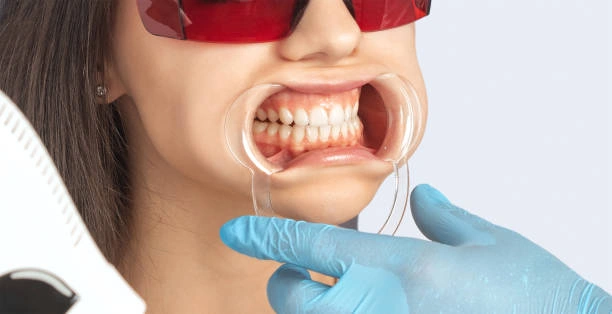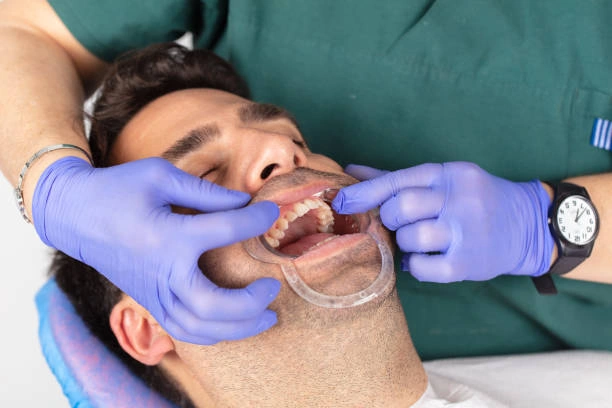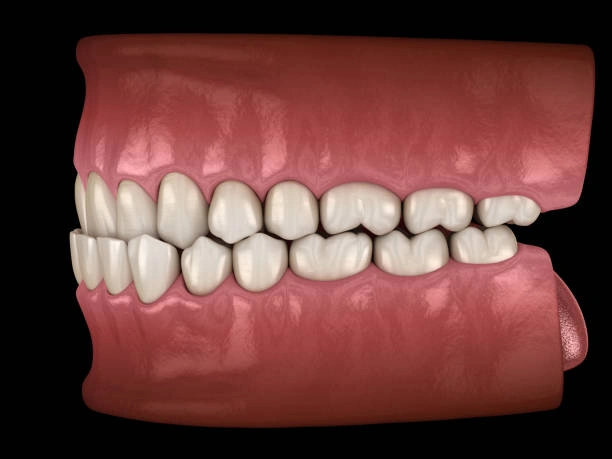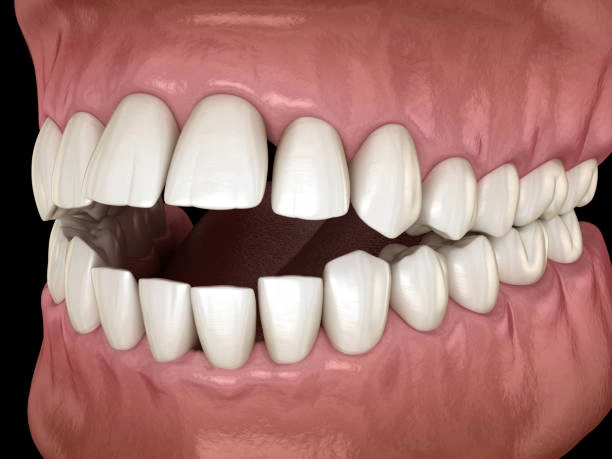Anterior Open Bite
The anterior open bite is considered one of the most prominent occlusal problems that cause both functional and aesthetic effects on oral health and quality of life.

Anterior Open Bite
Many people, both young and adult, suffer from difficulty closing their front teeth properly, which leads to a gap or space between the upper and lower front teeth when the jaws are closed.
The causes of the anterior open bite vary between childhood habits such as thumb sucking or pacifier use, to problems in jaw growth or genetic defects in the oral structure.
Dealing with the anterior open bite requires an accurate diagnosis and an individualized treatment plan for each case, whether the patient is a child or an adult, and whether the treatment is orthodontic or through cosmetic methods and specialized crowns.
In this article, we will discuss the treatment of open bite in adults, open bite treatment using crowns, and solutions for treating open bite without orthodontics, along with recent scientific updates and doctors’ recommendations.
Treatment of Anterior Open Bite in Adults
The anterior open bite presents a major challenge when it persists into adulthood, as bad habits often stabilize the occlusal problems, or the issue may develop due to unbalanced jaw growth.

Treatment of Open Bite in adults
Treating the anterior open bite in adults emerges as an essential option for an increasing number of patients who wish to restore the appearance of their smile and proper bite function.
Orthodontists and jaw specialists design combined treatment plans aimed at correcting the alignment of teeth and their roots.
Initially, panoramic X-rays and clinical examinations are performed to determine the degree of anterior open bite and whether it is related to the jaw structure or only to the teeth.
Traditional treatment for adults usually includes orthodontic treatment using fixed or transparent braces, lasting from 18 months to 3 years, depending on the severity and complexity of the case.
In certain cases where the skeletal imbalance is severe, surgical intervention to adjust the jaw position may be part of the treatment plan.
Here, patience and commitment are extremely important, as treating anterior open bite in adults requires close cooperation between the doctor and the patient, and awareness of the importance of time and adherence to instructions to ensure effective and lasting results.
Doctors emphasize that early detection shortens the treatment process and reduces the need for major interventions in the future.
Treatment of Open Bite Using Crowns
Among the modern options that have emerged in the field of anterior open bite treatment is open bite treatment with crowns, as a cosmetic solution for adults who do not wish to undergo long orthodontic treatment or surgical procedures — especially in mild to moderate cases.

Treatment of Open Bite Using Crowns
The concept of crowns (dental crowns or veneers) relies on modifying the appearance of the front teeth using ceramic shells or cosmetic crowns that alter the height or position of the teeth to reduce the visible gap between the jaws when smiling.
Diagnosis is first carried out to determine whether the anterior open bite is caused only by a dental issue or by a skeletal problem in the jaws.
In cases where the defect is superficial or purely cosmetic rather than functional, dental crowns for the front teeth may be recommended as a temporary or final alternative.
Treatment with crowns requires multiple visits for preparation, fitting, and continuous evaluation to ensure both the appearance and function are satisfactory.
However, it should be noted that treating open bite with crowns may not be suitable for all cases, as it does not address the root cause of the problem if there is jaw growth imbalance or muscular or psychological factors involved.
A comprehensive medical assessment remains essential before making a decision, with repeated emphasis that leaving the gap or treating it cosmetically without addressing the cause may lead to recurrence of the issue over time.
Treating Open Bite Without Orthodontics
Questions about the possibility of treating anterior open bite without orthodontics are increasingly common — either to avoid lengthy treatment periods, achieve faster results, or for personal reasons.

Open Bite After Orthodontic Treatment
Here, the doctor’s role is crucial in evaluating the feasibility of such treatment, as some minor open bite cases or those caused only by behavioral habits can be treated without complex orthodontic methods — by focusing on stopping the harmful habit and educating the patient about healthy oral practices.
Among the important non-orthodontic approaches are:
- The use of special oral devices that prevent the continuation of harmful behaviors (such as thumb sucking or tongue thrusting).
- Speech therapy sessions and oral muscle exercises to retrain natural muscle activity.
These solutions have good effects for young children or highly committed patients, but they are not a magical cure for all cases.
In some mild adult cases, cosmetic treatments such as corrective fillings or reshaping and smoothing of teeth can be combined.
However, the main goal remains to identify and treat the root cause of the anterior open bite accurately to prevent the gradual return of the problem.
It must be emphasized that the dentist is the primary reference for developing a realistic and safe treatment plan.
Anterior Open Bite – Conclusion
In conclusion, it is clear that the anterior open bite is a complex problem with multiple causes and solutions, and its treatment cannot be summarized in one procedure suitable for everyone.
A precise understanding of the underlying causes of the anterior open bite, clear patient expectations, and choosing the most appropriate treatment plan for each case form the foundation for a balanced smile and lifelong oral health.
Whether treatment involves adults, crowns, or non-orthodontic methods, early diagnosis and cooperation with the doctor remain the best investment in oral health, aesthetic appearance, and functional balance of the jaws and teeth.
Frequently Asked Questions (FAQ)
| Question | Answer |
|---|---|
| What is the anterior open bite? | It is the presence of a gap between the upper and lower front teeth when the jaws are fully closed. |
| Can anterior open bite be treated in adults? | Yes, it can be treated through orthodontics, crowns, or surgical methods depending on the severity and cause. |
| When are crowns used to treat open bite? | In mild or moderate cosmetic cases not caused by jaw or muscle imbalance, after doctor’s evaluation. |
| What are the ways to treat open bite without orthodontics? | Stopping bad habits, using special oral devices, speech therapy, muscle exercises, or simple cosmetic treatments. |
| Can open bite return after treatment? | Yes, if the root cause is not treated or doctor’s instructions are not followed, the gap may recur. |
